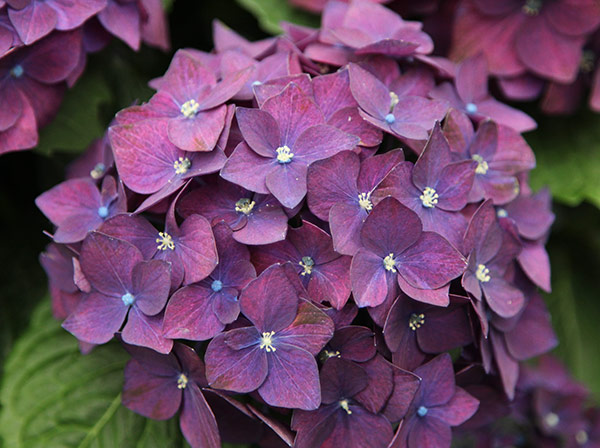Hydrangea (/ha?'dre?nd?i?/;common brands hydrangea or hortensia) is a genus of 70-75 types of flowering plants native to southern and eastern Asia (China, Japan, Korea, the Himalayas, and Indonesia) and the Americas. Certainly the greatest species diversity is in eastern Asia, notably China, Japan, and Korea. The majority are shrubs 1 to 3 meters tall, but some are small trees and shrubs, among others lianas attaining up to 30 m (98 foot) by climbing up trees and shrubs. They can be either deciduous or evergreen, though the cultivated temperate species are deciduous extensively.Having been introduced to the Azores, H. macrophylla is now very common, particularly on Faial, which is known as the "blue island" because of the multitude of hydrangeas present on the island.Life cycleHydrangea blossoms are produced from planting season to late autumn; they increase in flowerheads (corymbs or panicles) most often at the ends of the stems.
Usually the flowerheads contain two types of blooms: small non-showy flowers in the center or interior of the flowerhead, and large, showy blooms with large brilliant sepals (tepals). These showy blossoms tend to be expanded in a engagement ring, or to the surface of the tiny flowers. Plant life in outrageous populations typically have few to none of the showy blooms, while cultivated hydrangeas have been bred and picked to have significantly more of the bigger type plants.There are two flower arrangements in hydrangeas with Corymb style inflorescens, which includes the commonly grown "bigleaf hydrangea"--Hydrangea macrophylla. Mophead blooms are large spherical flowerheads resembling pom-poms or, as the name means, the comparative head of any mop. In contrast, lacecap flowers bear round, flat flowerheads with a center core of subdued, small blossoms ornamented by outer jewelry of much larger blossoms having showy tepals or sepals.
The blooms of some rhododendrons and viburnums can show up, at first glance, a lot like those of some hydrangeas.Dirt and colors acidityIn most varieties the plants are white, but in some species (notably H. macrophylla), can be blue, red, red, light crimson, or dark crimson. In these species the color is afflicted by the existence of aluminium ions which are available or tied up depending upon the soil pH. For H. macrophylla and H. serrata cultivars, the flower color can be dependant on the relative acidity of the soil: an acidic soil (pH below 7), will supply aluminum ions and typically produce flowers that are blue to purple, whereas an alkaline soil (pH above 7) will tie up aluminum ions and result in pink or red flowers.
This is caused by a color change of the bloom pigments in the presence of aluminium ions that can be adopted into hyperaccumulating plant life.[6] Decreasing the pH of potting soils or mixes usually does not change the blossom color to blue, because these soils haven't any aluminum ions. The ability to blue or pink a hydrangea is influenced by the cultivar also. Some plants are selected because of their ability to be blued, while some are bred and selected to be red, pink or white. The flower color of most other Hydrangea species is not influenced by aluminum and can't be changed or shifted. Hydrangeas also have a nickname called 'Change Rose'.
Buy lacecap hydrangea Hydrangea macrophylla 39;Dark Purple Black

Tidak ada komentar:
Posting Komentar